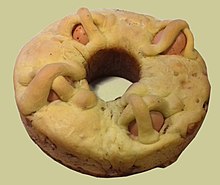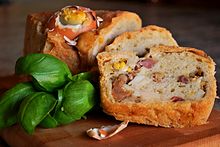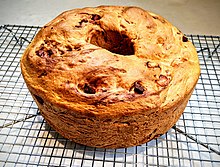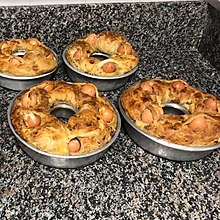Casatiello
 AcasatielloinRomein 2017 | |
| Type | Easter bread |
|---|---|
| Course | Main dish |
| Place of origin | Italy |
| Region or state | Campania |
| Serving temperature | Room temperature |
| Main ingredients | Wheat flour,salami,cheese, eggs,cracklings,lardandnatural yeast |
| Variations | Baker's yeast |
Casatiello(Neapolitan:casatiéllo;[1]Italian:casatello[2]) is aleavenedsavory breadoriginating from Naplesprepared during theEasterperiod.
Its basic ingredients are flour, lard, cheese, salami,cracklings,eggs and black pepper.[3]
Etymology
[edit]The bread's name derives probably from theNeapolitan wordcaso(Italian:cacio,'cheese', hencecasatiello), an ingredient that is part of its dough.[4]
History
[edit]The existence ofcasatiello,like that ofpastiera,another NeapolitanEaster product,has been attested at least since the seventeenth century: the proof comes from thefolk taleLa gatta Cenerentola(Cinderella the Cat) published in 1634–1636 in the short story collectionPentamerone, ovvero Lo Cunto de li cuntibyGiambattista Basile,a Neapolitan writer (writing in the Neapolitan language) who lived between the 16th and 17th centuries.[5][6][4][7]
The bread is mentioned in the passage where he describes the king's celebrations to find the girl who had lost herslipper:[6]
E, venuto lo juorno destenato, oh bene mio: che mazzecatorio e che bazzara che se facette! Da dove vennero tante pastiere e casatielle? Dove li sottestate e le porpette? Dove li maccarune e graviuole? Tanto che 'nce poteva magnare n'asserceto formato. |
And when the established day came, oh my goodness: what a chew and what a feast! Where did so many pastiere andcasatiellicome from? Where did the stews and meatballs come from? Where did the macaroni and ravioli come from? So much stuff that an entire army could eat. |
In the 19th century,casatiellois also mentioned in the bookCostumi e tradizioni di Napoli e dintorni(Customs and traditions of Naples and the surrounding area), published in 1858 and edited by Francesco De Bourcard, a Neapolitan scholar of Swiss origin, who describes the bread and its preparation, stating that the casatello (sic) was baked at home for theEasterlunch and offered as a gift to neighbors and "to the servants and thelaundress".[8][2]
Ingredients and preparation
[edit]
Casatiellois based on a bread dough enriched with cheese (usually smokedscamorza,but alsopecorinoand someParmesancan be used),[3][9]lard,ciccioliand other cured meats.[10][11]
The dough is worked into the shape of a doughnut, placed in a mould and left to rise for a long time, at least 12 hours; if made with quick leaven, about two hours are enough.[3]The bread is then baked, traditionally in awood-fired oven.[11]
Casatiellois usually prepared onGood Friday,left to rise overnight, baked the following day, and eaten on Holy Saturday andEaster Monday.[10]
Thecasatiello,unlike similar products such as tortano, is prepared around Easter, from which it borrows the symbolism: the strips of bread arranged to cage the eggs half-submerged in the dough[12]represent the cross on which Jesus died[13]while the ring shape is a reminder of the cyclical nature of theEaster resurrection[13]and ofChrist'scrown of thorns.[4]
During the preparation, the eggs are placed whole and baked in the oven together with the dough.[13]While some bakers put them raw, others prefer to use already hard-boiled eggs.[9]The cooking takes place at 170 °C (338 °F) for about 60 minutes.[14]
The bread can also be used as apacked lunchduring the traditional trips out of town (Italian:Gite fuori porta) on Easter Monday.[15]
Casatiellocan be kept for a maximum of two or three days, then it becomes harder and harder.[9]In Naples, a stalecasatiellois named "ammazzaruto"[9](lit. 'not enough leavened'),[16]and then by extension "hard".
Variants
[edit]
Tortanois a very similar product: the two main differences are the use of eggs, which incasatielloare also placed in the upper part and not only hard-boiled and in small pieces in the dough as in tortano, and that ofcharcuterie,which is part of the dough filling incasatiello,whereas it is omitted in tortano.[17]
Sweet variant
[edit]The sweet version ofcasatiellohas as main ingredients eggs, sugar, lard andicing,and is decorated on the surface withdiavulilli('little devils', Neapolitan for 'coloureddragées').[18][19]This variant is widespread inCaserta,[20]in theisland of Procidaand in theBeneventoandVesuvianarea.[8][19]Other sweet versions are found inMonte di Procidaand in theNolanoarea.[21][22]
In popular culture
[edit]
In reference to the heaviness of the dish, in Naples it is customary to say "Sí proprio 'nu casatiéllo"(Italian:sei proprio un casatiello;lit. 'You are really acasatiello'), to mean 'You are a person of quality but also an indigestible boring person'.[9]
See also
[edit]![]() Media related toCasatielloat Wikimedia Commons
Media related toCasatielloat Wikimedia Commons
References
[edit]- ^"Casatiéllo napoletano o Tòrtano? Quali le differenze?"(in Italian). 27 March 2016.Retrieved10 February2022.
- ^abde Bourcard 1866,p. 275.
- ^abcBarbagli 2002,p. 533.
- ^abcD'Avossa, Laura (8 March 2020)."Il Casatiello Napoletano, Le Origini, La Storia, La Simbologia".napolinpillole.it(in Italian). Archived fromthe originalon 7 November 2021.Retrieved5 November2021.
- ^D'Avossa, Laura (29 November 2020)."La Cenerentola Napoletana nella fiaba di Basile".storienapoli.it(in Italian). Archived fromthe originalon 7 November 2021.Retrieved5 November2021.
- ^abBasile, Giambattista."La gatta Cenerentola".ilportaledelsud.org.Archivedfrom the original on 3 February 2020.Retrieved5 November2021.
- ^"Pentamerone, or The Tale of Tales".wizzley.Archived fromthe originalon 7 November 2021.Retrieved5 November2021.
- ^abNunzia Clemente (12 April 2020)."Casatiello napoletano: storia e tradizioni del piccolo cacio".Dissapore(in Italian).Archivedfrom the original on 26 January 2021.Retrieved10 November2021.
- ^abcdeAlfè, Cinzia (24 March 2018)."Casatiello di Gino Sorbillo: 5 errori da non fare".Dissapore(in Italian).Archivedfrom the original on 29 November 2020.Retrieved8 November2021.
- ^ab"Ricetta del casatiello napoletano".caffecannella.it(in Italian).Archivedfrom the original on 24 April 2021.Retrieved5 November2021.
- ^abMassimo D'Alma (14 April 2019)."Casatiello napoletano. La ricetta scientifica spiegata in 5 punti".Scatti di gusto(in Italian).Archivedfrom the original on 1 March 2021.Retrieved8 November2021.
- ^de Bourcard 1866,p. 274.
- ^abcFiorini, Luca (14 April 2017)."La vera ricetta del casatiello napoletano".Vanity Fair Italia(in Italian). Archived fromthe originalon 15 April 2017.Retrieved15 April2017.
- ^Vv.Aa. 2006,p. 34.
- ^Sessa, Luca (25 March 2016)."Pasquetta in Casa Sessa: la ricetta del Casatiello".Il Giornale del Cibo(in Italian).Archivedfrom the original on 4 December 2020.Retrieved5 November2021.
- ^"Ammazzaruto".Dialetti d'Italia(in Italian).Retrieved11 November2021.
- ^"La differenza tra Tortano e Casatiello"(in Italian). Gran Caffè Gambrinus. 16 April 2019.Archivedfrom the original on 26 October 2021.Retrieved12 October2021.
- ^Capasso 2010,p. 101.
- ^ab"Casatiello Napoletano".giallo zafferano(in Italian).Archivedfrom the original on 9 November 2021.Retrieved5 November2021.
- ^Mariarosaria Clemente (13 April 2017)."Casatiello dolce: tipica bontà della pasqua casertana".caserta.italiani.it(in Italian).Archivedfrom the original on 8 August 2020.Retrieved10 November2021.
- ^Cannada Bartoli, Giulia (8 April 2020)."I Dolci Pasquali della Memoria: Il" Casatiello Dolce "dell'Isola di Procida".foodclub.it(in Italian). Archived fromthe originalon 7 November 2021.Retrieved5 November2021.
- ^Fiore, Francesca (23 July 2017)."La focaccia e i suoi derivati: 8 specialità dalla Campania e la ricetta del tortano".gamberorosso.it(in Italian). Archived fromthe originalon 10 November 2021.Retrieved5 November2021.
Cited sources
[edit]- de Bourcard, Francesco (1866).Usi e costumi di Napoli e contorni descritti e dipinti.Naples.
{{cite book}}:CS1 maint: location missing publisher (link)
Bibliography
[edit]- Emmanuele Rocco (1866) [1858]."Le Feste di Pasqua".In Francesco de Bourcard (ed.).Usi e costumi di Napoli e contorni descritti e dipinti(in Italian). Vol. 2. Napoli: Tipografia G. Nobile.
- Barbagli, Annalisa (2002).La cucina di casa del Gambero Rosso. Le 1000 ricette(in Italian). Roma: Gambero Rosso.ISBN8887180539.
- Vv.Aa. (2006). "Casatiello".L'Enciclopedia della Cucina Italiana(in Italian). Vol. 9. Novara: De Agostini. pp. 34–35.
- Capasso, Emilia (2010).I sapori della cucina vesuviana(in Italian). Napoli: Guida Editori.ISBN978-8860428172.
